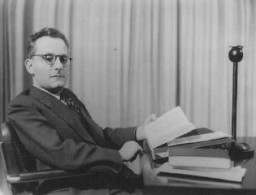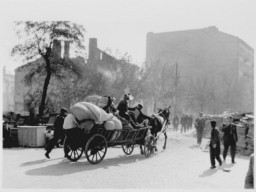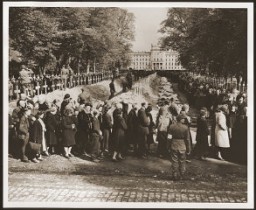You searched for: ������������������������������what���aptao168���plus
<< Previous | Displaying results 131-140 of 674 for "������������������������������what���aptao168���plus" | Next >>
-
Kurt Tucholsky
ArticleKurt Tucholsky was a German satirist who criticized the Nazis during their rise to power. In 1933, his works were burned under the Nazi regime. Learn more.
-
Max Brod
ArticleMax Brod was a Jewish author most widely known as the biographer and editor of Franz Kafka. His works were burned in the Nazi book burnings of 1933. Learn more.

-
Page from the Stroop Report
PhotoA page from SS officer Juergen Stroop's report on the Warsaw ghetto uprising. He wrote: "This is what the former Jewish residential quarter looks like after its destruction." Warsaw, Poland, April-May, 1943.

-
Refugees leave Warsaw
PhotoCivilians flee Warsaw following the German invasion of Poland. Hundreds of thousands of both Jewish refugees and non-Jewish refugees fled the advancing German army into eastern Poland, hoping that the Polish army would halt the German advance in the west. Many of the refugees fled without a specific destination in mind. They traveled on foot or by any available transport—cars, bicycles, carts, or trucks—clogging roads to the east. Most took only what they could carry.

-
Deadly Medicine
SeriesFrom 1933 to 1945, Nazi Germany carried out a campaign to "cleanse" German society of individuals viewed as biological threats to the nation's "health." Learn more
-
Soviet Prisoners of War
SeriesThe Nazis perpetrated mass murder against groups considered to be racial, civilizational, or ideological enemies. This included Soviet prisoners of war. Learn more
-
Displaced Persons Camps
SeriesLearn more about what life was like for Holocaust survivors living in DP camps after WWII. This series focuses on DP camps in the US zone of Allied-occupied Germany.
-
Burial of victims of Wöbbelin
PhotoGerman civilians from Ludwigslust file past the corpses and graves of 200 prisoners from the nearby concentration camp of Wöbbelin. The US Army ordered the townspeople to bury the corpses on the palace grounds of the Archduke of Mecklenburg. Germany, May 7, 1945. Outraged by what they found upon entering the camp, the ranking Allied commanders in the area forced civilians from the nearby towns of Schwerin, Hagenow, and Ludwigslust to view the concentration camp and then bury the bodies of prisoners…

-
The Bergen-Belsen concentration camp
PhotoA view of the Bergen-Belsen concentration camp after the liberation of the camp. Bergen-Belsen, after April 15, 1945. As it drove into Germany, the British 11th Armoured Division occupied the Bergen-Belsen concentration camp on April 15, 1945. When the 11th Armoured Division entered the camp, its soldiers were totally unprepared for what they found. Inside were more than 60,000 emaciated and ill prisoners in desperate need of medical attention. More than 13,000 corpses in various stages of…

-
Berlin environs, 1942
MapBerlin was a center of Jewish life in Germany and—as the capital of the Reich—also the center for the planning of the "Final Solution," the decision to kill the Jews of Europe. The Wannsee Conference, named for the resort district in southwestern Berlin where it was held, took place in January 1942. High-ranking officials from the Nazi party, the SS, and the German state met to coordinate and finalize what they referred to as the "final solution to the Jewish problem." At the conference, these…

